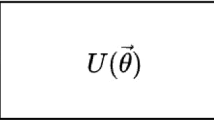Abstract
We analyse possibility to extend a quantum operation (sub-unital normal completely positive linear map on the algebra \(\mathfrak{B}(\mathcal{H})\) of bounded operators on a separable Hilbert space \(\mathcal{H}\)) to the space of all operators on \(\mathcal{H}\) relatively bounded w.r.t. a given positive unbounded operator.
We show that a quantum operation \(\Phi\) can be uniquely extended to a bounded linear operator on the Banach space of all \(\sqrt{G}\)-bounded operators on \(\mathcal{H}\) provided that the operation \(\Phi\) is \(G\)-limited: the predual operation \(\Phi_{*}\) maps the set of positive trace class operators \(\rho\) with finite value of \(\textrm{Tr}\rho G\) into itself.
Assuming that \(G\) has discrete spectrum of finite multiplicity we prove that for a wide class of quantum operations the existence of the above extension implies the \(G\)-limited property.
Applications to the theory of Bosonic Gaussian channels are considered.
Similar content being viewed by others
Notes
\(\mathfrak{B}(\mathcal{H})\) is the algebra of all bounded operators on a Hilbert space \(\mathcal{H}\).
It is easy to construct a channel \(\Phi\) and a positive operator \(A\) such that the domain of the r.h.s. of (1) contains only the zero vector.
The advantages of the norm \(||\cdot||_{E}^{G}\) in comparison with the equivalent norm commonly used on set of relatively bounded operators are described in Section 2.2.
The map \(\Phi\) is called normal if \(\Phi(\sup_{\lambda}A_{\lambda})=\sup_{\lambda}\Phi(A_{\lambda})\) for any increasing net \(A_{\lambda}\subset\mathfrak{B}(\mathcal{H})\) [7, 8]. This property is equivalent to existence of the predual map \(\Phi_{*}:\mathfrak{T}(\mathcal{H})\rightarrow\mathfrak{T}(\mathcal{H})\). The map \(\Phi\) is called unital (correspondingly, subunital) if \(\Phi(I_{\mathcal{H}})=I_{\mathcal{H}}\) (correspondingly, \(\Phi(I_{\mathcal{H}})\leq I_{\mathcal{H}}\)).
We identify operators coinciding on \(\mathcal{D}(\sqrt{G})\).
The value of \(\textrm{Tr}{G}\rho\) (finite or infinite) is defined as \(\sup_{n}\textrm{Tr}P_{n}G\rho\), where \(P_{n}\) is the spectral projector of \(G\) corresponding to the interval \([0,n]\).
After the article was accepted for publication this question was resolved positively, see Corollary 3 in https://arxiv.org/abs/2002.03969.
The function \(E\mapsto\left[|||A|||^{G}_{E}\right]^{p}\) is not concave in general for any \(p\in(0,2]\) [6, Section 3.1].
\(\mathcal{D}(\sqrt{G})\otimes\mathcal{K}\)is the linear span of all the vectors\(\varphi\otimes\psi\), where \(\varphi\in\mathcal{D}(\sqrt{G})\) and \(\psi\in\mathcal{K}\).
i.e. sub-unital CP normal linear map.
The concavity of the function \(E\mapsto Y_{\Phi}(E)\) implies that the nonnegative function \(E\mapsto Y_{\Phi}(E)/E\) is non-increasing and hence has a finite limit as \(E\rightarrow+\infty\).
If \(\Phi\) has the Stinespring representation (3) then the complementary map \(\widehat{\Phi}\) is defined as \(\widehat{\Phi}(A)=V_{\Phi}^{*}(I_{\mathcal{H}}\otimes A)V_{\Phi}\), \(A\in\mathfrak{B}(\mathcal{K})\) [1, Ch. 6]. Assuming that \(\mathcal{K}\) is a subspace of \(\mathcal{H}\) we may consider \(\widehat{\Phi}\) as a map from \(\mathfrak{B}(\mathcal{H})\) into itself.
T. V. Shulman, private communication.
Here \(||A||\) denotes the operator norm of a matrix \(A\).
The operators E-norms of the observables \(q\) and \(p\) in the case \(s=1\) are estimated in [6, Section 5].
\(\mathfrak{B}_{N}(\mathcal{H})\)and\(\mathfrak{B}_{N^{\prime}}(\mathcal{H}^{\prime})\) are the Banach spaces of \(\sqrt{N}\)-bounded operators on \(\mathcal{H}\) and \(\sqrt{N^{\prime}}\)-bounded operators on \(\mathcal{H}^{\prime}\) equipped with the norms \(||\cdot||_{N}^{E}\) and \(||\cdot||_{N^{\prime}}^{E}\) correspondingly (see Section 2.2).
REFERENCES
A. S. Holevo, Quantum Systems, Channels, Information. A Mathematical Introduction (Walter De Gruyter, Berlin, 2012).
J. Watrous, The Theory of Quantum Information (Cambridge Univ. Press, Cambridge, 2018).
M. M. Wilde, Quantum Information Theory (Cambridge Univ. Press, Cambridge, 2013).
T. Kato, Perturbation Theory for Linear Operators (Springer, New York, Heidelberg, Berlin, 1980).
B. Simon, Operator Theory: A Comprehensive Course in Analysis, Part IV (American Mathematical Society, 2015).
M. E. Shirokov, ‘‘Operator E-norms and their use,’’ arXiv:1806.05668v.5 (2019); Sb.: Math. (in Russian).
O. Bratteli and D. W. Robinson, Operators Algebras and Quantum Statistical Mechanics (Springer, New York, Heidelberg, Berlin, 1979), Vol. 1.
A. S. Holevo, Statistical Structure of Quantum Theory (Springer, Berlin, 2001).
W. F. Stinespring, ‘‘Positive functions on \(C^{*}\)-algebras,’’ Proc. Am. Math. Soc. 6, 211–216 (1955).
A. Winter, ‘‘Energy-constrained diamond norm with applications to the uniform continuity of continuous variable channel capacities,’’ arXiv:1712.10267 (2017).
M. E. Shirokov and A. S. Holevo, ‘‘Energy-constrained diamond norms and quantum dynamical semigroups,’’ Lobachevskii J. Math. 40 (10), 1569–1586 (2019).
M. Reed and B. Simon, Methods of Modern Mathematical Physics, Vol. 2: Fourier Analysis, Self-Adjointness (Academic, New York, London, 1980).
M. Reed and B. Simon, Methods of Modern Mathematical Physics, Vol. 1Functional Analysis (Academic, New York, London, 1980).
C. Weedbrook, S. Pirandola, R. Garcia-Patron, N. J. Cerf, T. C. Ralph, J. H. Shapiro, and S. Lloyd, ‘‘Gaussian quantum information,’’ Rev. Mod. Phys. 84, 621 (2012).
J. Eisert and M. M. Wolf, ‘‘Gaussian quantum channels,’’ in Quantum Information with Continuous Variables of Atoms and Light (Imperial College Press, London, 2007), pp. 23–42.
ACKNOWLEDGMENTS
I am grateful to A.S. Holevo and to the participants of his seminar ‘‘Quantum probability, statistic, information’’ (the Steklov Mathematical Institute) for useful discussion. I am also grateful to G.G. Amosov, A.V. Bulinsky, and V.Zh. Sakbaev for discussion and valuable remarks. Special thanks to T.V. Shulman for the example showing that the condition \(\dim\mathcal{K}<+\infty\) in Lemma 4 is essential and to S. Weis for the idea used (implicitly) in the proof of Lemma 2.
Author information
Authors and Affiliations
Corresponding author
Additional information
(Submitted by S. A. Grigoryan)
Rights and permissions
About this article
Cite this article
Shirokov, M.E. On Extension of Quantum Channels and Operations to the Space of Relatively Bounded Operators. Lobachevskii J Math 41, 714–727 (2020). https://doi.org/10.1134/S199508022004023X
Received:
Revised:
Accepted:
Published:
Issue Date:
DOI: https://doi.org/10.1134/S199508022004023X




